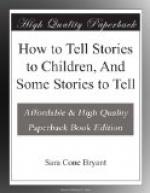This power is especially valuable in the case of children whose natural shyness has been augmented by rough environment or by the strangeness of foreign habit. And with such children even more than with others it is also true that the story is a simple and effective means of forming the habit of concentration, of fixed attention; any teacher who deals with this class of children knows the difficulty of doing this fundamental and indispensable thing, and the value of any practical aid in doing it.
More than one instance of the power of story-telling to develop attentiveness comes to my mind, but the most prominent in memory is a rather recent incident, in which the actors were boys and girls far past the child-stage of docility.
I had been asked to tell stories to about sixty boys and girls of a club; the president warned me in her invitation that the children were exceptionally undisciplined, but my previous experiences with similar gatherings led me to interpret her words with a moderation which left me totally unready for the reality. When I faced my audience, I saw a squirming jumble of faces, backs of heads, and the various members of many small bodies,—not a person in the room was paying the slightest attention to me; the president’s introduction could scarcely be said to succeed in interrupting the interchange of social amenities which was in progress, and which looked delusively like a free fight. I came as near stage fright in the first minutes of that occasion as it is comfortable to be, and if it had not been impossible to run away I think I should not have remained. But I began, with as funny a tale as I knew, following the safe plan of not speaking very loudly, and aiming my effort at the nearest children. As I went on, a very few faces held intelligently to mine; the majority answered only fitfully; and not a few of my hearers conversed with their neighbours as if I were non-existent. The sense of bafflement, the futile effort, forced the perspiration to my hands and face—yet something in the faces before me told me that it was no ill-will that fought against me; it was the apathy of minds without the power or habit of concentration, unable to follow a sequence of ideas any distance, and rendered more restless by bodies which were probably uncomfortable, certainly undisciplined.
The first story took ten minutes. When I began a second, a very short one, the initial work had to be done all over again, for the slight comparative quiet I had won had been totally lost in the resulting manifestation of approval.
At the end of the second story, the room was really orderly to the superficial view, but where I stood I could see the small boy who deliberately made a hideous face at me each time my eyes met his, the two girls who talked with their backs turned, the squirms of a figure here and there. It seemed so disheartening a record of failure that I hesitated much to yield to the uproarious request for a third story, but finally I did begin again, on a very long story which for its own sake I wanted them to hear.




